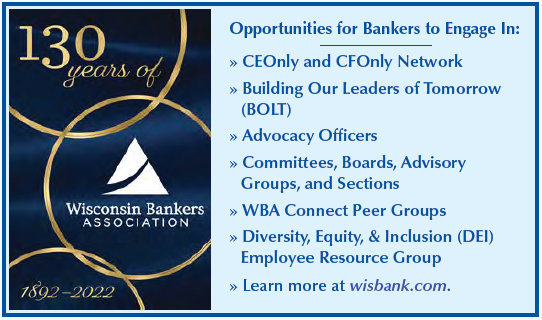Initiatives in eastern Wisconsin help to provide workforce housing
By Hannah Flanders
In July 2023, Governor Tony Evers signed into law Wisconsin’s largest ever investment into affordable housing. The historic $525 million investment helps to bolster the state’s affordable housing initiatives and establish loan programs that aid builders and developers to expand infrastructure, spur new construction, and prompt existing home improvements.
Already, bankers across the state are committed to fostering strong communities. With Wisconsin’s recent legislation, opportunities to support unique initiatives and help ensure equitable access to housing have only expanded. Housing supply and affordability have long been a concern across the state. While rental prices and the median cost of homes steadily rise, inventory continues to be a major issue. Throughout Q3 2023, Wisconsin hovered around only 7,600 active listings. As individuals and families in Wisconsin struggle to afford what limited property is available, many — including bankers — are concerned about the impact the housing market will have on Wisconsin’s workforce.
Supporting Housing Initiatives
In a report published by Forward Analytics in September 2022, it is estimated that 130,000 individuals representing the state’s working population will leave Wisconsin by 2030. Aiding in expanding affordable housing programs across Wisconsin is not only a significant way for banks to demonstrate their commitment to their communities; banks play a critical role in stabilizing communities, attracting and retaining talent, fostering economic growth, and helping local families to begin building their generational wealth.
Workforce housing, as defined by the Wisconsin Legislative Council, is housing that requires households to spend no more than 30% of 140% of the local area’s median income. These homes are intended for individuals or families whose household earnings do not surpass 140% of the area’s median income.
Already, several banks — including Cleveland State Bank, Collins State Bank, Oostburg State Bank, and Waldo State Bank — have partnered with the Sheboygan County Economic Development Corporation (SCEDC) to aid in actualizing the Forward Fund, a three-phase workforce housing project aiming to establish 600 entry-level homes in the county.
The Forward Fund was initially a $10 million investment in workforce housing spearheaded by Johnsonville LLC, Kohler Co., Masters Gallery Foods Inc., Sargento Foods Inc., and Sheboygan County. Working alongside the partnering Wisconsin-chartered banks in the area, developers are ensuring its future residents are able to access mortgages and loans that allow families to take the first step toward owning a home in Sheboygan County.
“It was in the best interest of our communities that we worked together,” notes Ben Becker, president of Collins State Bank, on the collaboration with Cleveland State Bank, Oostburg State Bank, and Waldo State Bank. “When people spend less on housing, they have more disposable income to spend on other goods and services, which can stimulate the local economies. When our community benefits, we benefit.”
With construction underway, the first project — Founders’ Pointe in Sheboygan Falls — is expected to be completed by the end of 2024 and feature 54 single-family units available for under $250,000.
“Upon completion of the project, there will be opportunities for permanent financing, and other financial institutions could get involved,” says Becker. “Several other communities are currently exploring similar projects for affordable housing, which will create additional opportunities for involvement throughout Wisconsin.”
In Washington County, leaders, employers, and workers have also expressed concern over the state of the county’s quality and stock of houses. As such, the Washington County Community Development Department established the Next Generation Housing Initiative in 2021.
With a mission to bring 1,000 new owner-occupied housing units under $420,000 by 2032, the initiative has already broken ground on two pilot developments — The Oaks of Jackson subdivision and lots 67–73 in the Skyway Park subdivision (Hartford). Between the two developments, the initiative will make 108 single- and mixed-family homes available to area residents.
Brian Heckendorf, senior vice president – director of community banking at Westbury Bank and village president of Jackson, Wisconsin, has a hand in the project not just from a banking standpoint, but as a community leader as well.
“I see this development helping various demographics from first-time homebuyers all the way to empty nesters that are looking to downsize,” Heckendorf notes. “This housing initiative will also help our local businesses fill their staffing needs better by keeping more people working and living in Washington County.”
Through Westbury Bank’s involvement in the program, several bankers helped to provide expertise as the County worked to establish guidelines for the initiative. “Working alongside a team of realtors, lenders, title companies, attorneys, and Washington County employees, our goal is to ensure that new homeowners looking to buy are able to obtain conventional loans,” adds Heckendorf.
In addition to the Forward Fund and Next Generation Housing Initiative, the Northeastern Wisconsin Housing Community Development Block Grant (CDBG) Loan Program helps to address the affordable housing as well as community and economic development needs of non-urban areas of Brown, Calumet, Door, Fond du Lac, Kewaunee, Manitowoc, Marinette, Outagamie, Sheboygan, and Winnebago counties.
Since 2014, the state CDBG-funded program has been administered by Brown County in order to provide 0% deferred loan payment housing rehabilitation loans to low- and moderate- income (LMI) owner-occupied households and small-scale neighborhood-oriented public facilities improvements, among other activities, to residents. Larger cities, including Appleton, Fond du Lac, and Sheboygan, receive CDBG funds directly from the U.S. Department of Housing and Urban Development (HUD).
Housing Provisions
While several preexisting initiatives continue to make investments in affordable housing across the state, Wisconsin’s 2023–2025 state budget also included several supplemental items in support of local workers, families, and communities that are predicted to make a historic impact across the state.
In the spring of 2023, the Workforce Housing Package was first introduced by Assembly Housing Chair Robert Brooks (R–Saukville) and Senate Housing Chair Romaine Quinn (R–Cameron) after a year of discussions between a coalition made up of the League of Wisconsin Municipalities, Wisconsin Builders Association, Wisconsin Counties Association, Wisconsin Housing and Economic Development Authority (WHEDA), Wisconsin REALTORS® Association, and Wisconsin Towns Association. The package garnered bipartisan support in both the State Assembly and Senate before being signed into law. The programs then received funding as part of the 2023– 2025 state budget.
“With this package, the coalition was most concerned with spurring the development of workforce housing,” notes Brad Boycks, executive director of the Wisconsin Builders Association. “The first step in making housing in Wisconsin more accessible is providing developers with the resources to both build and remodel single- and multifamily homes.”
The 2023 Wisconsin Housing Package encompasses the following five laws:
- Act 14: Residential Housing Infrastructure Loan Fund
Creates a residential housing infrastructure revolving loan fund and loan fund program. Both programs are administered by WHEDA and awarded to developers for the purpose of workforce or senior housing. Loans may also be awarded to the governmental unit having jurisdiction over the development.
- Act 15: Main Street Housing Rehabilitation Loan Fund
Creates a main street housing rehabilitation revolving loan fund and loan fund program. Both programs are administered by WHEDA and awarded to the owner of single-family or multifamily rental housing for the purpose of housing rehabilitation.
- Act 16: Local Regulation of Property Development
Addresses the judicial review of local residential development decisions; approval of permits for residential housing developments; the procedure for amending a zoning ordinance; appeal of county conditional use permit decisions; and planned development district zoning.
- Act 17: Workforce Housing Rehabilitation Loan Program
Modifies certain parameters of the workforce housing rehabilitation loan program to expand upon the specifics — including type of rehabilitation and type of home — that are eligible for a loan. Additionally, the Act allows WHEDA to establish an interest rate (at or below market rate) for a workforce housing rehabilitation loan.
- Act 18: Commercial-to-Housing Conversion Loan Fund
Creates a commercial-to-housing conversion revolving loan fund and loan fund program. Both programs are administered by WHEDA and awarded to the developer to cover construction costs for the conversion of a vacant commercial building to a new residential housing development that consists of workforce or senior housing.
For bankers, the 2023 Wisconsin Housing Package encourages banks to foster partnerships with WHEDA that significantly enhance the banks’ ability to assist customers in accessing these housing programs tailored to their specific needs. This collaboration not only helps banks to extend their traditional financial services by ensuring their customers are aware of the resources available to them, but bankers are also able to understand the nuances of each program and guide their customers effectively.
“While the loans provided by WHEDA are not meant to be the primary source of funding, it is important for bankers to know and understand what is included in the 2023 Housing Package in order to share the affordable opportunities with their customers,” notes Tom Larson, president and CEO of the Wisconsin REALTORS® Association. “By bridging financial gaps and offering support beyond conventional services, banks reinforce their dedication to the well-being of their customers and the communities they serve.”
Taking the Lead
As initiatives and opportunities for affordable housing emerge across the state, bankers have the unique opportunity to invest in their existing and future neighbors.
“In the last several years, many of us have experienced a very tight workforce environment while housing costs, whether renting or owning, continued to increase significantly,” says Becker. “Affordable housing directly contributes to the overall well-being and prosperity of a community, and we, as community bankers, have the opportunity and responsibility to support strategies that align with our mission to serve the needs of our communities.”




 Tionne Riley leads life with ambition for anything she sets her mind to. A former customer service representative at a local grocery store, Riley was ready for a change. When her stepmother gave her a Wisconsin Department of Workforce Development flyer for BankWork$, it was meant to be.
Tionne Riley leads life with ambition for anything she sets her mind to. A former customer service representative at a local grocery store, Riley was ready for a change. When her stepmother gave her a Wisconsin Department of Workforce Development flyer for BankWork$, it was meant to be. According to
According to